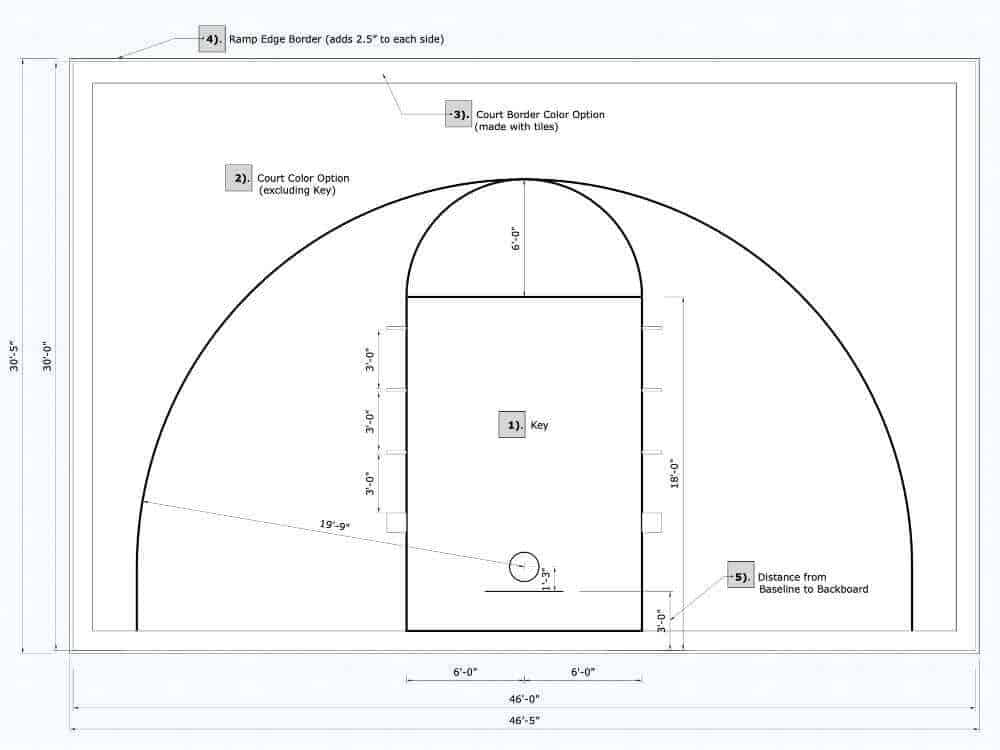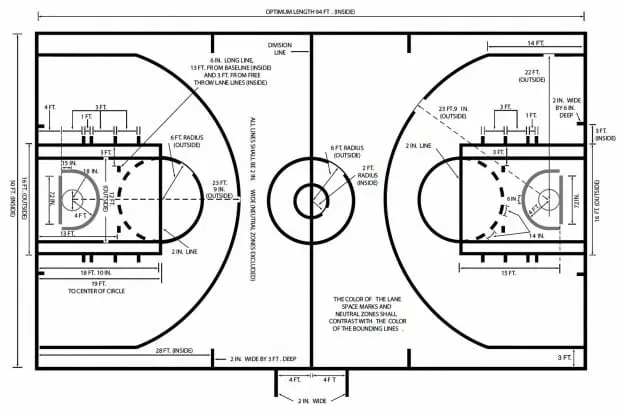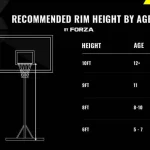
Half court basketball is a popular variant of the full-court game, ideal for small-scale play, training, and recreational spaces. Whether you’re designing a home court, building a gymnasium, or planning a training facility, understanding the standard half court basketball dimensions is essential. This guide provides a comprehensive breakdown of the layout, measurements, and line markings based on international and recreational standards.
Content
Why Choose a Half Court?
A half court basketball setup offers many benefits:
- Requires less space and resources
- Promotes skill-based training
- Ideal for 1v1, 2v2, or 3×3 games
- Easier maintenance and installation
Due to its compactness, half court dimensions are increasingly popular in urban settings, school gyms, and home gardens.
Standard Half Court Basketball Dimensions

The standard half court size is typically half the length of a full court, but the width may vary depending on the level of play.
| Level of Play | Width (m) | Length (m) |
| NBA Half Court | 15.24 | 14.33 |
| FIBA Half Court | 14.00 | 15.00 |
| High School Half Court | 13.72 | 14.00 |
| Recreational Court | 12.00 | 13.00 |
Note: Measurements can slightly vary based on the organization or purpose of the court (e.g., training vs. competition).
Key Line Markings and Areas
1. Boundary Lines
The outermost lines that mark the play area. These include:
- Sidelines (long edges)
- Baseline (short edge behind the hoop)
Basketball court measurements must ensure that lines are clearly painted and meet minimum width standards (5cm is typical).
2. Centre Line and Circle
Even though a half court does not require a full centre line, the centre circle is often painted in home and school setups for practice and aesthetics.
- Centre circle radius: 1.8m (standard FIBA/NBA)
3. Three-Point Line
A vital scoring arc in all levels of play. On a half court, it remains fully drawn to provide authentic shooting practice.
- NBA 3-point arc: 7.24m from the basket
- FIBA 3-point arc: 6.75m
- High school: Approx. 6.32m
4. Free Throw Line and Key (Paint Area)
The free throw line is 4.57m (15 feet) from the backboard. The key or “paint” is a rectangular area under the basket that supports rebounding and defensive drills.
- Width: 4.88m (NBA), 4.9m (FIBA)
- Height from baseline: 5.8m to free-throw line
5. Restricted Area and No-Charge Circle
Although not mandatory for recreational play, a no-charge semi-circle area under the hoop enhances realistic practice for drive and charge scenarios.
- Radius: 1.25m from the centre of the basket
Player Zones and Spectator Areas

While not a core part of basketball court dimensions, smart court designs include:
- Team bench areas outside the sidelines
- Spectator seating zones at least 1.5m from sidelines
- Safety buffers for run-offs and walkways
Mini Basketball and 3×3 Variants
Mini Basketball Courts
For children aged 5–12, mini-basketball setups offer smaller dimensions:
- Length: 12–14m
- Width: 7–8m
- Hoop height: 2.6m instead of 3.05m
This promotes easier scoring and encourages young players to enjoy the game while learning.
3×3 Half Court Basketball
The 3×3 basketball format uses a half court and is recognized by FIBA as an official global sport. It has:
- Court size: 15m x 11m
- Ball: Size 6 with weight of a Size 7
- One hoop, one half court, one shot clock
It’s fast-paced, simple to host, and perfect for community competitions.
Construction Considerations

Building a half court basketball setup involves:
- Surface: Concrete or modular sports tiles
- Markings: Durable weather-proof paint
- Hoop system: Portable or in-ground
- Drainage: Crucial for outdoor installations
- Lighting: For night-time use
Space-saving layouts with accurate basketball court measurements ensure usability and safety.
Useful Guidelines and References
To maintain compliance with international rules and safe dimensions, consult:
- FIBA Official Basketball Rules
- NBA Court Specifications
- Local school or recreational sport authority guidelines
Conclusion: Making the Most of a Half Court
Understanding accurate half court basketball dimensions helps players, coaches, and facility designers build efficient, safe, and fun basketball setups. From FIBA 3×3 formats to school mini courts, every layout has its specifications. Whether you’re converting a backyard or installing an indoor gym, refer to official basketball court dimensions to ensure optimal playability and fairness.
Half-court basketball requires precise measurements for optimal play. Players need clear boundary lines, proper hoop height, and spacing. Brands can reach enthusiasts effectively if they choose to advertise with us, connecting with a dedicated sports audience.
By investing in correct half court size, you lay the foundation for skill growth, community engagement, and high-performance basketball practice.
FAQs About half court basketball
Q1. What are the standard half court basketball dimensions in feet?
A standard NBA half court is 50 feet wide by 47 feet long. Recreational courts can be smaller, around 42 feet by 50 feet.
Q2. Can I build a half court basketball setup at home?
Yes. A typical residential half court basketball setup ranges from 30×30 to 50×42 feet, depending on available space and budget.

Eldon Barrett’s knowledge of sports is boundless. His in-depth analysis and captivating storytelling will make you see the games you love in a whole new light.


